 In memory ever green of the life and work of Dr. Elsie Quarterman (1910-2014),
so more people will know what she did and how she did it, as her many students and relatives continue her work.
In memory ever green of the life and work of Dr. Elsie Quarterman (1910-2014),
so more people will know what she did and how she did it, as her many students and relatives continue her work.
This is the picture of Aunt Elsie in high school that sat on the mantle in her room at her parents’ house at the farm for many decades. The first item below is Elsie speaking for herself about her work, her teachers, and her students.
The other items are in chronological order, newest first. More will be added.
-
 MTSU Center for Cedar Glade Studies, Cedars of Lebanon State Park,
29 January 2009, video of the 11 April 2008
dedication of Elsie Quarterman Cedar Glade Wildflower Festival,
MTSU Center for Cedar Glade Studies, Cedars of Lebanon State Park,
29 January 2009, video of the 11 April 2008
dedication of Elsie Quarterman Cedar Glade Wildflower Festival,
Separate blog post of this video.
-
Dr. Elsie Quarterman, Plant Ecologist, remembered at Cheekwood.
-
Dr. Elsie Quarterman, Champion of the Cedar Glades and Natural Areas, by Brian Bowen, TN Conservationist Magazine, Sep-Oct 2014,
Dr. Quarterman was a longtime member of the Natural Areas Association, the professional organization representing the interests of natural area professionals in the US. She received the NAA George Fell Lifetime Achievement Award in 2008 at the 35th Annual Natural Areas Conference in Nashville. In receiving the award, she humbly said that there “is no greater honor than to be recognized by my peers.” Her most significant legacy will be the thousands of acres of natural areas she helped to protect in Tennessee including the cedar glades and the once endangered Tennessee Coneflower.
-
 2014-Summer:
Elsie was more than a biology professor and ecologist —Jonathan Ertelt
2014-Summer:
Elsie was more than a biology professor and ecologist —Jonathan Ertelt
Students of all ages are thankful that her appreciation of the plant kingdom and the world around her touched them and made their lives.
-
2014-09-19:
The whole ecosystem –Elsie Quarterman on Wild Side TV, including this from a 2006 interview by MTSU:
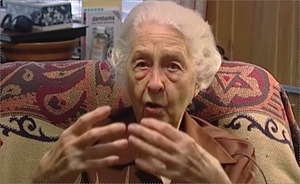 The general public needs to know what’s around them. They need to be learning that there’s a world that is not paved. There are lots of things that have life and function in the whole scheme, people as well as plants and animals. Not just dogs you’ve got on a leash, but animals that live out there, are part of the whole ecosystem.
The general public needs to know what’s around them. They need to be learning that there’s a world that is not paved. There are lots of things that have life and function in the whole scheme, people as well as plants and animals. Not just dogs you’ve got on a leash, but animals that live out there, are part of the whole ecosystem.
-
 2014-07: Carol and Jerry Baskin wrote for the July 2014 issue of Southeastern Biology,
newsletter of The Association of Southeastern Biologists,
SEB: Professor Elsie Quarterman: In Memorium, 1910-2014
2014-07: Carol and Jerry Baskin wrote for the July 2014 issue of Southeastern Biology,
newsletter of The Association of Southeastern Biologists,
SEB: Professor Elsie Quarterman: In Memorium, 1910-2014
Dr. Quarterman will be remembered as a fine southern lady who loved her family and students, studied cedar glades, had a deep appreciation of the value of natural ecosystems and worked tirelessly for the preservation of natural plant communities.
- 2014-06-22:
Dr. Quarterman’s ground-breaking work will continue –Dr. J. Richard Carter,
 I also
remember that she very kindly gave me a set of reprints of
her classic
paper (with Dr. Keever) on ecological succession in the coastal plain
of the southeastern United States. I still require my local flora and
dendrology students to read this paper, and until fairly recently we
had access to Troupville Woods just west of Valdosta, one of her study
sites.
I also
remember that she very kindly gave me a set of reprints of
her classic
paper (with Dr. Keever) on ecological succession in the coastal plain
of the southeastern United States. I still require my local flora and
dendrology students to read this paper, and until fairly recently we
had access to Troupville Woods just west of Valdosta, one of her study
sites.
-
Memorial service for Elsie Quarterman in Nashville, TN 2014-06-21
-
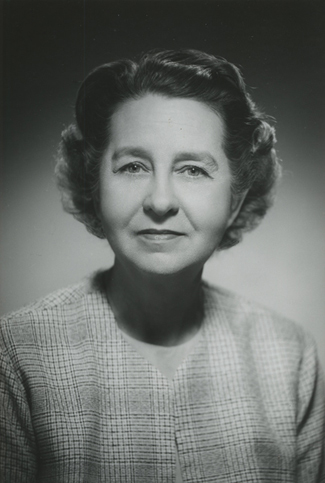 Vanderbilt University News 12 June 2014,
Elsie Quarterman, who rediscovered Tennessee coneflower, dies at 103,
Vanderbilt University News 12 June 2014,
Elsie Quarterman, who rediscovered Tennessee coneflower, dies at 103,
“Elsie possessed an incredible wealth of knowledge about plants that she was always happy to share with you,” said Jonathan Ertelt, Vanderbilt’s greenhouse manager, who encountered Quarterman regularly when he served as a greenhouse specialist and botanical education coordinator at Nashville’s Cheekwood Botanical Garden from 1978 to 1987. Over the years, the two saw each other at conferences and meetings of various plant societies, and both served on the Tennessee Environmental Council.
- 2014-06-11:
Remembering Elsie Quarterman –Paul Somers, Ph.D.
Perhaps the time that I needed Elsie the most was when a proposed route for Interstate 840 was slated by the Tennessee Department of Transportation to go directly through a very significant cedar glade known as Sunnybell Glade, named as such because of its dense stands of a yellow-flowered member of the lily family commonly known as sunnybells. My initial meeting or two with officials at the Department of Transportation were cordial
 but resulted in no change
to their plans, so I turned to friends in the media and within 24
hours Elsie was being interviewed by Nashville TV networks about the
significance of the glade and its resources. Within another 24
hours, we learned that
an alternative route would be considered, and
soon, after some further planning and public hearings, the glade was
spared. It is now
a state-owned and managed natural area.
but resulted in no change
to their plans, so I turned to friends in the media and within 24
hours Elsie was being interviewed by Nashville TV networks about the
significance of the glade and its resources. Within another 24
hours, we learned that
an alternative route would be considered, and
soon, after some further planning and public hearings, the glade was
spared. It is now
a state-owned and managed natural area.
-
Josh Brown wrote for
The Tennessean 10 June 2014 page 8A,
Nashville botanist Elsie Quarterman dies at 103
“She was one of the first female ecologists that we had in America,” said Kim C. Sadler, a professor in Middle Tennessee State University’s biology department.
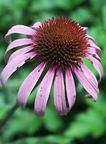 Dr. Quarterman’s work with the Tennessee coneflower began in 1969
when she and a student were said to have noticed the plant while
driving. At the time, the flower that had been endemic to cedar
glades in Middle Tennessee was thought to be extinct.
Dr. Quarterman’s work with the Tennessee coneflower began in 1969
when she and a student were said to have noticed the plant while
driving. At the time, the flower that had been endemic to cedar
glades in Middle Tennessee was thought to be extinct.
Focus on cedar glades
Much of her career was focused on understanding the ecology of cedar glades — areas globally unique to Middle Tennessee that feature shallow soil and limestone outcroppings.
The sites are home to groves of gnarled cedar trees and drought- and heat-resistant plants such as leafy prairie clover and the coneflowers.
Her influence can also be seen in the number of botanists who followed in her footsteps.
Jerry Baskin, who spent 43 years as a botany professor at the University of Kentucky, studied under Dr. Quarterman as a graduate student at Vanderbilt in the 1960s. Her influence is what in part led him to the research field.
“I think that was the major turning point,” Baskin said.
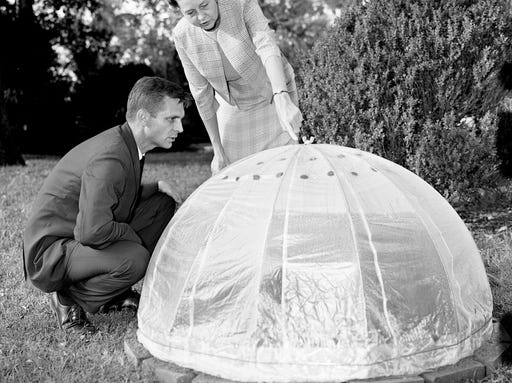
Dr. Ben Channell, left, and Dr. Elsie Quarterman view the mystic bubble, a plant propagation unit, at Cheekwood on Sept. 5, 1963.(Photo: File / The Tennessean) -
 Nina Cardona wrote for WPLN
Nashville Public Radio 13 June 2014,
Remembering The Champion Of Middle Tennessee’s Cedar Glades, Elsie Quarterman,
and a broadcast story sometime Friday, 13 June 2014 on Nashville Public Radio.
Here’s the audio.
Nina Cardona wrote for WPLN
Nashville Public Radio 13 June 2014,
Remembering The Champion Of Middle Tennessee’s Cedar Glades, Elsie Quarterman,
and a broadcast story sometime Friday, 13 June 2014 on Nashville Public Radio.
Here’s the audio.
Middle Tennessee lost a trailblazing woman this week. Elsie Quarterman began working at Vanderbilt as a lab assistant during World War II; roughly twenty years later, she was head of the biology studies—the university’s first female department chair. But her greatest legacy is in the small forest clearings she studied and preserved.
Cedar glades are places where the limestone bedrock is barely covered with a very thin layer of soil. Most plants and trees can’t grow there. But many of those that do are unusual species found nowhere else on earth. Elsie Quarterman loved them, calling them “flower gardens par excellence.”
-
 John S. Quarterman wrote for Canopy Roads of South Georgia 9 June 2014,
Dr. Elsie Quarterman, November 28th 1910 – June 9th 2014
John S. Quarterman wrote for Canopy Roads of South Georgia 9 June 2014,
Dr. Elsie Quarterman, November 28th 1910 – June 9th 2014
Today Aunt Elsie stepped over the final fence, dying peacefully at her home in Nashville, Tennessee, attended by her nephew Patrick and his wife Ann, as she had wanted.
-
Mary Priestley wrote for Sewannee Herbarium 9 June 2014,
Dr. Elsie Quarterman 1910-2014
 Dr. Elsie Quarterman, professor emerita, Vanderbilt University,
passed away peacefully in her sleep this afternoon; she was 103 ½
years old (DOB 11-28-10). Her documentation of the flora of the
old-growth forest in Savage Gulf led directly to the preservation of
Savage Gulf State Natural Area. She was the first plant ecologist to
systematically study limestone cedar glades and influential in the
protection and conservation of thousands of acres of premier
Tennessee land. There is much more to say about Elsie, who was a
remarkable person who touched the lives of so many people.
Dr. Elsie Quarterman, professor emerita, Vanderbilt University,
passed away peacefully in her sleep this afternoon; she was 103 ½
years old (DOB 11-28-10). Her documentation of the flora of the
old-growth forest in Savage Gulf led directly to the preservation of
Savage Gulf State Natural Area. She was the first plant ecologist to
systematically study limestone cedar glades and influential in the
protection and conservation of thousands of acres of premier
Tennessee land. There is much more to say about Elsie, who was a
remarkable person who touched the lives of so many people.
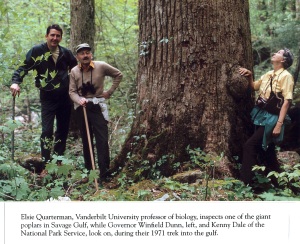 Dr. Quarterman was my academic “grandmother” — her
student Dr. Tom Hemmerly was my major professor in graduate school.
A few years ago, I visited her to deliver a certificate from the
Tennessee Native Plant Society designating her our
“Conservationist of the Year.” When I arrived, I found
her out on the patio watering her potted geraniums. I was struck by
the image of this scientist who had such a deep understanding of
plant ecology enjoying this simple potted plant. I, too, love
geraniums, and I think of Elsie when I water mine. Thank you, Elsie,
for this bond — and for much, much more.
Dr. Quarterman was my academic “grandmother” — her
student Dr. Tom Hemmerly was my major professor in graduate school.
A few years ago, I visited her to deliver a certificate from the
Tennessee Native Plant Society designating her our
“Conservationist of the Year.” When I arrived, I found
her out on the patio watering her potted geraniums. I was struck by
the image of this scientist who had such a deep understanding of
plant ecology enjoying this simple potted plant. I, too, love
geraniums, and I think of Elsie when I water mine. Thank you, Elsie,
for this bond — and for much, much more.
 Picture at top was taken in a cedar glade in middle Tennessee in
1947. Middle photo was taken in soon-to-be-designated
Savage Gulf State Natural Area in 1971; last photo was taken in Elsie’s home,
circa 2008.
Picture at top was taken in a cedar glade in middle Tennessee in
1947. Middle photo was taken in soon-to-be-designated
Savage Gulf State Natural Area in 1971; last photo was taken in Elsie’s home,
circa 2008.
-
The Vasculum, The Society of Herbarium Curators Newsletter, Vol. 8, No. 1, January 2013,
Featured Herbarium: BRIT — The Philecology Herbarium, Botanical Research Institute of Texas,
Vanderbilt University Herbarium (VDB)
The VDB Herbarium was founded at Vanderbilt University (Nashville, Tennessee) in 1935 by professors of Biology George Gage and Harold Bold. In the 1940s and 50s the curatorship went to Dr. Elsie Quarterman, then on to Dr. R. Ben Channell. In 1965, Dr. Robert Kral inherited the herbarium of approximately 20,000 specimens and concentrated on developing the collections from Tennessee, Alabama, Florida, and Georgia, as well as the following taxonomic groups: sedges, xyrids, and grasses. In the early 1990s, facing the upcoming retirement of Kral, the university began exploring alternative homes for the collection and considered dividing it up amongst regional universities. Kral sent out “dear colleague” letters in 1993 asking for the botanical community to write university administrators and fight for space and the hiring of a tenure-track professor and curator for the collection. At some point, the predicament of the VDB collection was characterized for the BRIT board, and discussions began between the two institutions about the possibility of BRIT as a potential recipient of the collection. In March of 1996, Madeleine Goodman (Dean of College of Arts and Sciences) was invited to BRIT to meet with the BRIT board, and in June of that year a memorandum of understanding was signed between BRIT and VDB, permanently transferring the VDB collection to BRIT. At BRIT, the specimens retain their identity as part of the VDB collection, two positions on the BRIT board are made available to Vanderbilt University representatives, and a space for Kral to continue research and curatorial projects as a Research Associate is provided.
 At the time of transfer to BRIT in October 1997, the VDB herbarium
consisted of more than 320,000 specimens with most in cabinets (176
full height metal and 20 half-cases) and some in boxes. Geographic
concentration of the collection focused on the southeastern U.S.A.
and Mesoamerica. Taxonomically the collection focused on
the Cyperaceae, Eriocaulaceae, Liliaceae s.l., Poaceae,
Asteraceae, Lamiaceae, and Melastomataceae. Important collections
include: Jesse Shaver fern collections (10,000), C. Bryson, R.
Carter, D. Demaree, A. Gholson, R.K. Godfrey, L. McKinney, R.
Norris, M. Pyne, Paul Somers, and the Frederick Wolf teaching and
research collections of fungi. Conveniently, the filing system of
VDB was nearly identical to that of BRIT-SMU, alphabetized by
family, genus, then geographically separated by region, then
alphabetized by species. It is a wonder how much of this was due to
the fact that for a short time, Kral was a M.S. student of Shinners
(prior to leaving to pursue a Ph.D. under R.K. Godfrey at Florida
State University). For several years, the VDB collection was housed
in a separate building from the main BRIT Herbarium, but is now
fully incorporated into the collection.
At the time of transfer to BRIT in October 1997, the VDB herbarium
consisted of more than 320,000 specimens with most in cabinets (176
full height metal and 20 half-cases) and some in boxes. Geographic
concentration of the collection focused on the southeastern U.S.A.
and Mesoamerica. Taxonomically the collection focused on
the Cyperaceae, Eriocaulaceae, Liliaceae s.l., Poaceae,
Asteraceae, Lamiaceae, and Melastomataceae. Important collections
include: Jesse Shaver fern collections (10,000), C. Bryson, R.
Carter, D. Demaree, A. Gholson, R.K. Godfrey, L. McKinney, R.
Norris, M. Pyne, Paul Somers, and the Frederick Wolf teaching and
research collections of fungi. Conveniently, the filing system of
VDB was nearly identical to that of BRIT-SMU, alphabetized by
family, genus, then geographically separated by region, then
alphabetized by species. It is a wonder how much of this was due to
the fact that for a short time, Kral was a M.S. student of Shinners
(prior to leaving to pursue a Ph.D. under R.K. Godfrey at Florida
State University). For several years, the VDB collection was housed
in a separate building from the main BRIT Herbarium, but is now
fully incorporated into the collection.
-
Ray City History Blog 21 May 2011,
Elsie Quarterman, Noted Ecologist, Once Resident of Ray City,
 After high school, Elsie Quarterman attended Georgia State Womans
College in Valdosta, GA (now known as Valdosta State University.)
The 1931 Pine Cone, the college annual, gives her home town as Ray
City, GA. Elsie graduated from G.S.W.C. in 1932 with a Bachelor of
Arts degree.
After high school, Elsie Quarterman attended Georgia State Womans
College in Valdosta, GA (now known as Valdosta State University.)
The 1931 Pine Cone, the college annual, gives her home town as Ray
City, GA. Elsie graduated from G.S.W.C. in 1932 with a Bachelor of
Arts degree.
Actually, the postal address of the farm was Ray City, GA, as it still was for some time when I was growing up there, but the farm was always in Lowndes County, not Berrien County.
-
Tennessee Botanists Hall of Fame, Elsie Quarterman,
Elsie Quarterman was born in 1910 in Georgia…. The Elsie Quarterman Cedar Glade State Natural Area was named in her honor in 1998.
-
John S. Quarterman and other relatives and friends wrote for Clan Sinclair in 2011,
Elsie Quarterman (1910-), Centenarian Ecologist,
Dr. Elsie Quarterman, Ph.D., remembers the celebrations at the end of World War I in Valdosta, Georgia, where she was born 100 years ago in November 1910. Her father David Sinclair Quarterman was from an old Georgia family, and her mother Alla Irene Peek traced her line back to colonial Virginia (with many Scots in both lines).
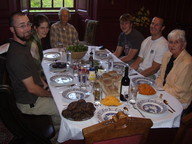 Elsie’s father’s mother was Susan Evalyn “Susie” Sinclair. Susie’s
father was Benjamin Waters Sinclair, who emigrated from Thurso to
Georgia in 1837. B.W.’s descendants are scattered across the U.S.
southeast. His parents were Alexander Sinclair, merchant of Thurso,
and Catherine “Kitty” Waters, of Brims Castle; they are buried in
Old St. Peters Kirk in Thurso. Alexander of Thurso’s father was
William of Clarville, son of John of Golval, son of Alexander; many
Canadian Sinclairs descend from this line.
Elsie’s father’s mother was Susan Evalyn “Susie” Sinclair. Susie’s
father was Benjamin Waters Sinclair, who emigrated from Thurso to
Georgia in 1837. B.W.’s descendants are scattered across the U.S.
southeast. His parents were Alexander Sinclair, merchant of Thurso,
and Catherine “Kitty” Waters, of Brims Castle; they are buried in
Old St. Peters Kirk in Thurso. Alexander of Thurso’s father was
William of Clarville, son of John of Golval, son of Alexander; many
Canadian Sinclairs descend from this line.
Elsie moved with the family to the family farm in 1921, where she first learned about wild plants from her mother. She played basketball at Hahira High School, and taught school in Morven, Georgia. In 1937 her sister Jane supplied a car for a trip her brother David organized with Elsie, their cousin Helen Quarterman, and friend Mary Small across the country to see the new Golden Gate Bridge.
I’m told she actually played basketball in college, not high school. -jsq
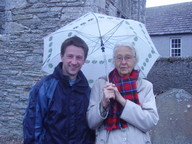 …dining with family in Roslin Castle on the way to see Rosslyn
Chapel.
…dining with family in Roslin Castle on the way to see Rosslyn
Chapel.
As our driver James Campbell from Edinburgh sought an obscure location on a narrow Highland road, he suggested turning back, when a voice was heard back in the bus: “No, keep going! It’s like a field trip with graduate students!” That was Elsie, of course.
-
Bonnie Arant Ertelt wrote for Vanderbilt Magazine vol. 82 no. 2 Fall 2000 page 31,
James Folsom: Hooked on Plants,
James Folsom, MA’79, has made it his life’s work to pay attention to plants. As director of the Huntington Botanical Gardens in San Marino, California, one of the largest and most diverse collections in the United States, Folsom rides herd on more than 10,000 species of plants….
“We’re building a whole educational program around the world’s most interesting plants, using them to teach different lessons. For instance, you can take a lotus in full sun, put water in the top of a leaf, and see these huge bubbles coming up. It shows an active process, an exchange of gases, in an exciting way. It allows us to talk about biological and physical processes and the challenges faced by plants growing in mucky soils—in this case, the lack of sufï¬cient oxygen in the soil to allow growth of roots and stems. If you can get children and adults to look at a process, you have a better chance of capturing their imagination.”
Folsom’s hands-on approach stems directly from his days at Vanderbilt, where Ben Channell and Elsie Quarterman, both professors of biology, emeriti, were mentors. During his nearly four years at the University, Folsom spent practically all of his time in the ï¬eld, studying native orchid populations in the southeast….
“Ben was such a prodigious teacher,” he says. “I received an incredible grounding in field biology cruising the southeast, traveling all the way from Big Bend, Texas, to the coastal plain of Delaware, and even camping in Apalachicola National Forest for two full summers studying these plants.
“I gained a valuable insight from my field experiences at Vanderbilt. If you go into your studies with very logical and well-conceived notions, you have to be willing to throw them out and look at the data fresh or sometimes you won’t be able to make progress. It’s true in science, it’s true in writing articles, and I’ve taken that approach in running the gardens, too. That was a good lesson for me, one that’s proved to be invaluable.”
-
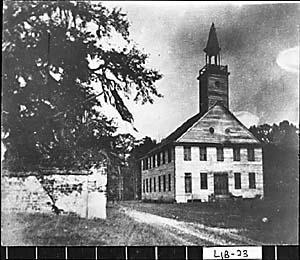 Quarterman Family
of Liberty County, Georgia
and Relatives,
by Jane Quarterman Comer,
David Leon Quarterman,
Stephen Patrick Quarterman,
John Sinclair Quarterman, 1997,
Reprint Company, LCCN 97-69321 ISBN 0-87152-510-0,.
Quarterman Family
of Liberty County, Georgia
and Relatives,
by Jane Quarterman Comer,
David Leon Quarterman,
Stephen Patrick Quarterman,
John Sinclair Quarterman, 1997,
Reprint Company, LCCN 97-69321 ISBN 0-87152-510-0,.
Elsie provided this epigraph on the title page:
“If you don’t know who you are
or where you come from,
you will find yourself at a disadvantage.”
—Andrew Lytle, in A Wake for the Living - Elsie Quarterman and Catherine Keever 1962. Southern Mixed Hardwood Forest: Climax in the Southeastern Coastal Plain, U.S.A. Ecological Monographs 32:167–185. http://dx.doi.org/10.2307/1942384
What a great lady!
Best regards to all the Quarterman Family.
Mark Anderson
Pingback: Memorial service for Elsie Quarterman in Nashville, TN 2014-06-21 | Canopy Roads of South Georgia
Pingback: Elsie Quarterman WPLN audio | Canopy Roads of South Georgia
Pingback: Dr. Elsie Quarterman, Plant Ecologist, at Cheekwood | Canopy Roads of South Georgia
Pingback: Elsie Quarterman, Noted Ecologist, Once Resident of Ray City | Ray City History Blog
This lady was definitely a remarkable and learned individual instrumental in middle Tennessee beautiful ecosystem.